Last week AMD introduced the new RX 470 and I took a look at XFX’s fastest model, the RX 470 RS Black Edition. Well, today I’m going to follow that up and take a look at Sapphires RX 470 4GB Nitro. This will be my first look at one of the new 400 series Nitro cards and I’m excited to find out what Sapphire has going on. From looking through some of the feature lists I saw removable fans and RGB lighting but I’m most curious about the overall performance of the overclocked card and the cooling capabilities of the Nitro cooler. So today I’m going to take a look at the card, its features, and then test its performance in our GPU benchmark suite to see how it compares to the RX 470 from XFX. Considering how close the XFX came to the RX 480 in some of our tests Sapphire has their work cut out for themselves.
Product Name: Sapphire RX 470 4GB Nitro
Review Sample Provided by: Sapphire
Written by: Wes
Pictures by: Wes
Amazon Link: HERE
| Specifications | |
| GCN Architecture | 4th Generation |
| Manufacturing Process | 14-nm FinFET |
| Die Size | 232 mm2 |
| Transistors | 5.7B |
| Compute Units | 32 |
| Stream Processors | 2048 |
| Clock Speeds (Boost / Base) | 1260 MHz / 1143 MHz |
| Peak Compute Performance | Up to 4.9 TFLOPS |
| Texture Units | 128 |
| Peak Texture Fill-Rate | Up to 154.4 GT/s |
| ROPs | 32 |
| Peak Pixel Fill-Rate | Up to 38.6 GP/s |
| Memory Size | 4 GB |
| Memory Bandwidth | 211 GB/s |
| Memory Interface | 256 bit |
| Memory Type | GDDR5 |
| Board Power | 120W |
| AMD FreeSync™ Technology | Yes |
| DirectX® 12 Suppor | Yes |
| Vulkan™ Support | Yes |
| VR Premium | Yes |
| DisplayPort Version | 1.3 HBR / 1.4 HDR Ready |
Before diving into testing, I did want to include a copy of the GPUz from the card. With issues popping up this year with manufacturers sending review samples that are turned up to their optional OC clocks I want to make sure we keep everything transparent. The Nitro does run at the 1260MHz boost clock that is listed in the Sapphire specifications, so we are good there.
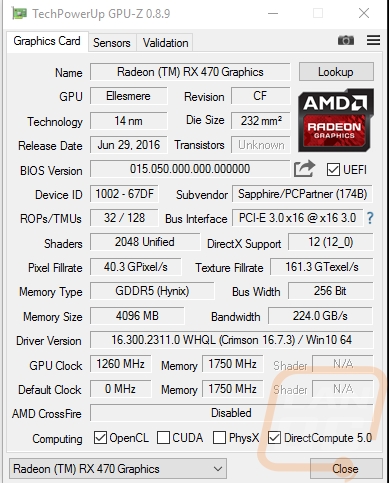
Packaging
The packaging for the RX 470 Nitro is a little different than the last few Sapphire cards that I have covered, but it is consistent with what I saw from the RX 480 cards. It is skinny and tall and has a black background. On the front, they have the Sapphire Nitro robot in the background. Up top is the Sapphire logo as well as the Nitro RX 470 OC branding. Then down closer to the bottom AMD cards now have a similar consistent design like Nvidia has been doing for years. It has the Radeon logo, the memory, and the RX 470 branding. The back of the packaging actually has a picture of the card on it though it is a lot smaller than I would like. Personally, I would prefer there just be a huge picture of the card on the front. They talk a little about the Nitro gaming series of cards and then list off some of the product features. Some of the features are the normal AMD card features like Crossfire and Eyefinity support but there are also a few Sapphire exclusives like the Nitro Glow RGB and the FanSafe tech.


Inside of the box, there is a second box. In THAT box you will find foam padding up the top and the bottom. Then inside the card comes wrapped up in Sapphires static protective bag that also has padding built in. Then all of the included documentation sits on top. You get a driver disc, a quick installation guide, a paper with information on Sapphire, and a color page that explains how to register your card.



Card Layout and Features
Well, Sapphire went a completely different direction with their new cards. The Nitro’s design has the normal two cooling fans but for the fan shroud they dropped the multi-colored accents and went with a simpler design. When it was first posted up during the RX 480 launch the overall response was mixed. Some aren’t a fan of the holes in the shroud and a few even called it a cheese grater. But I personally am a big fan of the design. I like a simple design that will work in just about anything and this fits that bill perfectly. The overall cooler is shorter than the reference design but also about ¾ of an inch above the top of the PCI slot. It looks like they could have cut the height down just slightly if they pushed the fans down to the bottom edge of the shroud, though.


Like the reference design, the Nitro cooler does have an enclosed top. This continues with the simple and clean design. Rather than having the heatsink and heatpipes exposed this will look better in your PC. The top has the Sapphire logo and one silver accent that runs most of the length of the top. The bottom of the card is a little more open. We can see large heatpipes running from the GPU out but the shroud does have a few sections that stick down, this doesn’t leave much room for air to come out here.


On the end of the card, we have a lot going on, so much so that I had to split it up from the two pictures above that I normally keep it with. For starters here we have a completely open end, this is one of two directions all of the heated air that has been blowing over the heatsink will go. In fact, this is the main direction as it is less restricted than the PCI slot end of the card. On the end, we can also see the heatsink. There were some complaints with the RX 480 Nitro cards because people felt the heatsink didn’t utilize the space under the shroud. I can see where they are coming from here. The heatsink doesn’t even go to the height of the two fans, it could be a little taller given the shroud height. It also looks like there might be some space unused in thickness as well. Part of that is because of the decision to go with a power connection out of the end of the card. The RX 470 has an 8-pin power connection, something that the reference RX 480 could have used. This should mean no issues on power draw off the PCIe bus this time around!

The backplate design that Sapphire went with is completely the opposite of what they went with for the other side of the card. The rest of the card is simple, muted, and clean but the backplate is crazy. That said I dig the look. The silver, gray, and black theme looks good together. They have the Sapphire and Nitro logos facing out so they will be visible when you have the card installed in your PC. There are is a cutout at the back of the GPU to let out heat as well as angled vents up near the top edge .

There is also a cutout up near where you used to see a crossfire bridge connection. Here Sapphire has slipped in two things onto their PCB. They have a V BIOS switch to switch between a UEFI and a legacy BIOS up on the top edge. There there is a red push button. This lets you flip between lighting modes for the RGB lighting.


The RGB lighting is exclusively on the Sapphire logo on the top edge of the card. It defaults to blue, but there are a few other colors you can flip between. Each color has a breathing mode as well. There is a mode that will slowly rotate between the colors for those who can’t pick. They also have modes that show PCB temperature or fan speeds to give you a visual indicator of how your card is doing. Sapphire will also let you set specific colors with their upcoming TriXX 3.0 software but I didn’t get a chance to check that out.

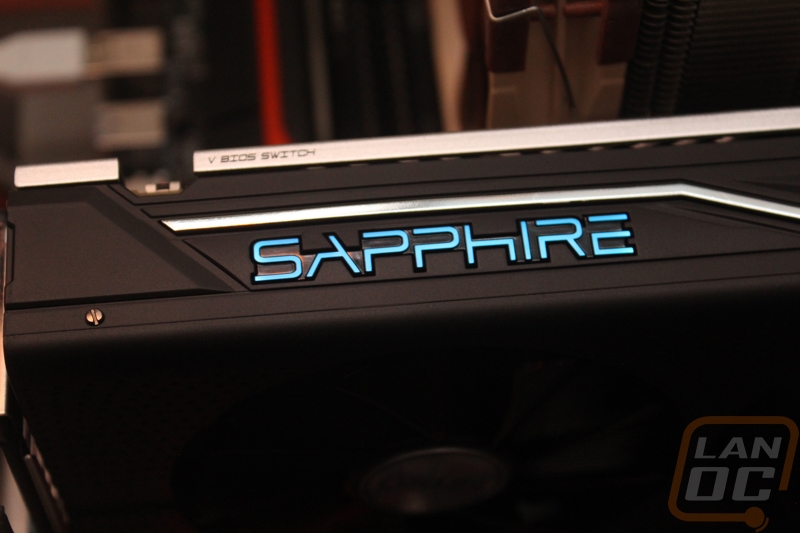
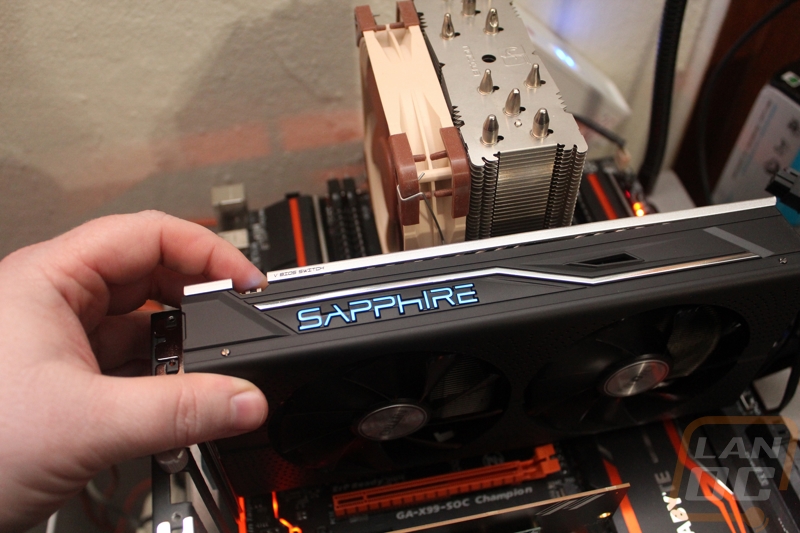
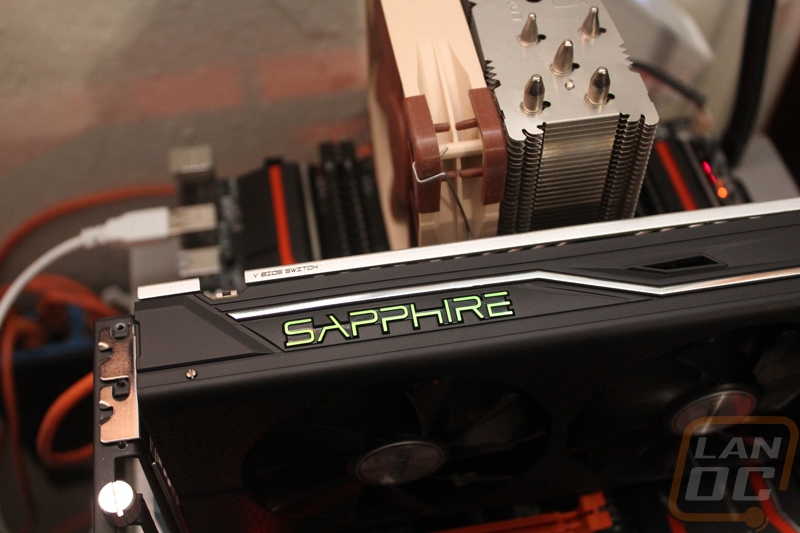
Back on the PCI slot at the end of the card, the RX 470 Nitro has a slightly different connection setup. You get one DVI, two DisplayPorts, and two HDMI. This is one less DisplayPort and one more HDMI than any of the other cards I’ve tested recently. It is also one DVI more than the reference design. Given the popularity of HDMI, it’s not a bad thing to have a second included. The DVI port does take up half of the cooling room though so Sapphire cut large vents in the section above it. I think they could have slipped a few smaller vents in the gaps between ports like some of the other manufacturers have been doing, especially with the Nitros design pushing all of its air out the ends of the card.

The last feature I wanted to touch on is what Sapphire is calling FanSafe. Both of the cooling fans on the Nitro cooler can actually be removed with just a single screw. XFX has a similar tech this generation but is screwless. This is a big improvement over the older designs where you had to remove the shroud, unplug the fan, then remove 3 or 4 screws. This design isn’t really about cleaning, though I think if you want to get a better clean you could with this. Basically, 80% of RMAs for video cards are fans dying or making noise. Having you pay to ship your card back, replacing the fan, and sending it back to you is expensive both to you and to Sapphire. Not only that leaves you without a card for a while. The idea here is when this issue comes up, they will send you a fan and you can quickly swap it out. It should save in RMA costs all around and in turn help lower card costs. But more importantly, you don’t have to be without a card. I gave it a try and it wasn’t too hard. I had to use a smaller screwdriver and getting the screw back in gave me trouble because I dropped it a few times. But I would take this over being without a video card any day!

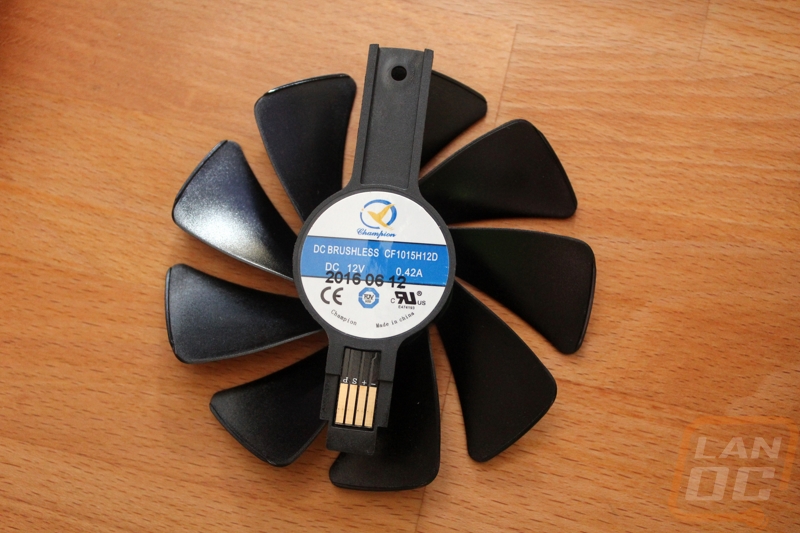
Our Test Rig and Procedures
| Our Test Rig | ||
| CPU | Intel i7-5960X | Live Pricing |
| Memory | Kingston HyperX FURY Black 32GB Quad Channel Kit 2666 MHz | Live Pricing |
| Motherboard | Gigabyte X99-SOC Champion | Live Pricing |
| Cooling | Noctua NH-U12S Cooler | Live Pricing |
| Power Supply | Cooler Master V1000 Power Supply | Live Pricing |
| Storage | Kingston Hyper X Savage 960GB SSD | Live Pricing |
| Case | Dimastech Test Bench | Live Pricing |
| Our Testing Procedures | |
| 3DMark | The same goes for the most current version of 3DMark using the Fire Strike benchmark in normal, extreme, and ultra settings |
| Unigine Valley Benchmark 1.0 | Using the Extreme HD preset to get an average FPS |
| Catzilla 4k | Default tests for 1080p, 1440p, and 4k resolutions using the overall score for each as our result |
| SteamVR | Default SteamVR test using Average Quality score |
| HITMAN 2016 | Fullscreen with V-Sync turned off Detail, Texture Quality, Shadow Maps, and Shadow Resolution all set to their highest settings. We test using both DX11 and DX12 at both 1080p and 1440p resolutions. |
| Ashes of the Singularity | Built-in benchmark ran at 1080p and 1440p with graphics settings set to the “Crazy” setting with the exception of turning off V-Sync Mode. The benchmark scenario is set to GPU Focused and we use the Average Framerate for All Batches as the result. Tests are run both in DX11 and DX12 |
| The Division | Built-in benchmark ran at 1080p and 1440p with graphics settings set to the default “Ultra” setting with the exception of turning off V-Sync Mode |
| Bioshock Infinite | Using the Adrenaline Action Benchmark Tool we run Bioshock Infinite on the “Xtreme” quality setting. This has a resolution of 1920x1080, FXAA turned on, Ultra Texture detail, 16x Aniso Texture Filtering, Ultra Dynamic Shadows, Normal Postprocessing, Light Shafts on, Ambient Occlusion set to ultra, and the Level of Detail set to Ultra as well. We also run this same test at 2560x1440 using the same settings as mentioned above. |
| Tomb Raider | Using the Adrenaline Action Benchmark Tool we run Tomb Raider on the “Xtreme” quality setting. This has a resolution of 1920x1080, Exclusive Fullscreen turned on, Anti-Aliasing set to 2xSSAA, Texture Quality set to Ultra, Texture Aniso set to 16x Aniso, Hair Quality set to TressFX, Shadow set to Normal, Shadow Resolution on High, Ultra SSAO, Ultra Depth of Field, High Reflection quality, Ultra LOD scale, Post-Processing On, High Precision RT turned on, and Tessellation is also turned on. We also run this same test at 2560x1440 using the same settings as mentioned above. |
| Hitman: Absolution | Using the Adrenaline Action Benchmark Tool we run Hitman: Absolution on the “Xtreme” quality setting other than the MSAA setting is turned down from 8x to 2x. That setting puts the resolution at 1920x1080, MSAA is set to 2x, Texture Quality is set to High, Texture Aniso is set to 16x, Shadows are on Ultra, SSA is set to high, Global Illumination is turned on, Reflections are set to High, FXAA is on, Level of Detail is set to Ultra, Depth of Field is high, Tessellation is turned on, and Bloom is set to normal. We also run this same test at 2560x1440 using the same settings as mentioned above, except on the “high” setting. |
| Sleeping Dogs | Using the Adrenaline Action Benchmark Tool we run Sleeping Dogs on the “Xtreme” quality setting. That means our resolution is set to 1920x1080, Anti-Aliasing is set to Extreme, Texture Quality is set to High-Res, Shadow Quality is High, Shadow Filter is set to high, SSAO is set to High, Motion Blur Level is set to High, and World Density is set to Extreme. We also run this same test at 2560x1440 using the same settings as mentioned above. |
| Total War: ROME II | Ultra-setting tested at 1920x1080 and 2560x1440, built in forest benchmark |
| Middle-earth: Shadow of Mordor | Using the built-in benchmark we test with ultra settings at 1440p |
| Sniper Elite 3 | Ultra-setting tested at 1920x1080 and 2560x1440, built in benchmark |
| Thief | Tested using the “Very High” setting at 1920x1080 and 2560x1440 |
| Folding at Home 2.2 | Using the Folding at Home benchmark 2.2.5 set to OpenCL, WU set to dhfr, and run length set to the default 60 seconds. We test at both double and single precision and use the score at the result |
| CompuBenchCL | Video Composition and Bitcoin tests |
| Unigine Valley Benchmark 1.0 heat testing | We run through Unigine Valley using the “Extreme” preset for 30 minutes to test in game cooling performance with the fan speed set to auto then again with the fan set to 100%. |
| Power Usage | Using Unreal Valley Benchmark 1.0, we get our “load” power usage number from the peak power usage during our test. We get our numbers from a Kill-A-Watt connected to the test benches power cord. |
| Noise Testing | Our Noise testing is done using a decibel meter 3 inches away from the video card on the bottom/fan side of the card. We test an idle noise level and then to get an idea of how loud the card will get if it warms all the way up we also turn the fan speed up to 50% and 100% and test both speeds as well. The 100% test isn’t a representation of typical in-game noise levels, but it will show you how loud a card can be if you run it at its highest setting or if it gets very hot. |
Synthetic Benchmarks
As always to start off my testing I run through a few different synthetic benchmarks. These don’t always show exactly what you will experience in game, but they are consistent and give us a good look at performance differences between different cards. Before I do that though I do want to touch on the clock speeds of the Sapphire and XFX RX 470s. Sapphire lists a base clock of 1143 MHz and a boost clock of 1260 MHz. XFX is a little more confusing, they don’t offer a base clock at all but in the information they sent over for our review says the boost clock is 1256 MHz. But on their website they are now showing 1280 Mhz. I can say though that the card I tested last week was locked at 1256 MHz. So going by that the sapphire card has a 4 MHz advantage on the boost clock. The performance numbers from my first tests do have me questioning that, though.
The reason is because in 3DMark Fire Strike the Sapphire card performed WELL above the XFX, 500 points above in face on the 1080p testing. This almost puts the Sapphire RX 470 in the middle between the XFX 470 and the reference RX 480. In Time Spy the Sapphire card once again outperformed the XFX 470. This extra performance also put it ahead of the GTX 980 in this test. The RX 480 has a bigger performance gap in that test.


In the Valley Benchmark, the extra clock speed translated into a 1.4 FPS difference. It's rare to see this big of a gap between similar GPU models, especially when there isn’t a big gap in overclocking. I suspect it is throttling related, but we will have to see how the cooling testing turns out later.

In Catzilla, once again the Sapphire Nitro outperformed the XFX 470. I’m still impressed with how close this puts us with our 8GB RX 480.

For the last benchmark, I take a quick look at VR performance using Steams VR benchmark. Here the Sapphire falls into the green good for VR category. Like the XFX this is still on the low end of good, but it did get an extra .3 over the XFX. The reference RX 480 was only at a 6.9 so a 6.4 is an impressive number for having fewer stream processors and less vRAM.

In-Game Benchmarks
I was impressed with the Sapphire Nitro in our synthetic benchmarks but it’s the in-game benchmarks I was most curious about. I ran the Nitro RX 470 through 25 different in-game tests. This included 11 games at 2 different resolutions and in a few games I also take a look at both DX 11 and DX 12 performance (don’t worry more are coming soon). The problem is, with so many results it can be a little too much to take in. To help with that I have condensed our results into two graphs, one for 1080p and the other for 1440p. All of our games are run at their max settings and we use the average FPS as the end result. The graphs below are broken down into three FPS ranges to represent unplayable (below 30), playable but not ideal (30 to 60), and ideal (over 60 FPS). So what did I find from those results? Well at 1080p almost every game came in at 60FPS or higher. As always Ashes of the Singularity slowed things down, but all of the single card setups struggle there. The Sapphire RX 470’s results were close to the XFX, but with one more card up over 60 FPS. At 1440p is where I was the most surprised. The Nitro RX 470 actually performed well here. All but three games were playable but 6 games were in the 60+ range. This is amazing compared to the XFX card that only had 2 games in that 60+ section.


The reason for the jump in performance over the XFX in our previous charts was due to a 3-4 FPS improvement almost across the board. This was enough to push a lot of the games from playable into the perfect range at 1440p. The results I saw in the synthetic benchmarks carried over into all of our in-game results. The Sapphire card managed to outperform the XFX in every game. This put the Sapphire RX 470 4Gb up close to the performance of the GTX 980 and the reference RX 470 8GB in a good portion of the games, even 1 or 2 FPS away in a few. I was happy with the RX 470 in my previous review, but with this bump, it gets even more impressive.













Compute Benchmarks
Next, I wanted to take a look at the Compute performance of the Sapphire RX 470 Nitro. To do this I ran it in Folding at Home benchmarks as well as CompuBenchCL to get a look at a range of different compute results. The first tests in Folding at Home take a look at folding performance in both single and double precision situations. Here the RX 470 Nitro came extremely close to the RX 480 in the single precision benchmark. With double precision testing the extra stream processors really helped the 480 stay ahead. In both results, the Sapphire stayed up ahead of the XFX RX 470.


In CompuBenchCL testing I focused on just Video Composition and Bitcoin testing. In video composition testing the XFX and Sapphire cards were neck and neck and just a touch behind the GTX 1060. In Bitcoin mining, the RX 470’s are still well behind the RX 480 but the lead the Sapphire card put n the XFX pushed it up right with the GTX 980 and the GTX 1060.


Cooling, Noise, and Power
Typically comparing overall performance numbers between two cards with the same GPU isn’t all that exciting, this time around though the Sapphire card really did outperform the similarly clocked XFX RX 470. So I was especially curious to take a look at this batch of testing to see if we might be able to pinpoint why. Our cooling, noise, and power testing is where we see the differences in cards from manufacture to manufacture. We can see if one card is pulling more power, better or worse cooling performance, and also just how much noise you can expect as well. To start off my testing I put the Sapphire RX 470 4GB Nitro through our power test. This is where we monitor overall wattage of our testbench with a Kill-A-Watt and loop Valley Benchmark, documenting the peak wattage pulled. With the XFX RX 470, I was concerned because it was within only a few watts of the 150 TDP RX 480 while the RX 470 has a TDP of 120 watts. Sapphire completely blew past that though and pulled 35 more watts than the reference RX 480. When I spoke with Sapphire about this I was told they wanted to make sure their card was rock solid at their overclock without underclocking and they did this with a heavy voltage increase. Well, we know it worked. The case is clearly not power efficient at all, but it was fast for an RX 470. They did upgrade the 6-pin for an 8-pin power unlike XFX, so the extra power isn’t coming from the PCI slot.

Next, I tested the dual fan setups noise output. This test isn’t anything like a real world test. I test using a decibel meter 4 inches away from the fans on an open air test bench, In a normal case, you would most likely hardly hear any of the cards tested except at 100% fan speed. This test does help us compare the difference between cards, no matter how small. Here the dual fans of the Nitro cooler were a little loud at 100% fan speed but still a touch better than the XFX 470. At 50% fan speed, however, the Sapphire card was louder. I think this is because of the shroud design that ends up pushing more out the ends of the card than most aftermarket coolers. That limitation does create aa little more wind resistance and can especially be seen in the blower design of the reference RX 480.

My last test was testing the 470 Nitro’s cooling performance. I do this by looping Heaven Benchmark over and over until the temperature levels out. I test once with the fan settings set to their out of the box settings to get an idea of normal performance with any stock fan profiles, then I test again with the fans turn to 100% to see the true cooling capabilities of the cooler. At stock settings the Sapphire card came in warmer than the XFX card and higher than any of the other aftermarket cooler cards I have tested. With the fans turned up those numbers did drop about 20 degrees right next to the XFX 470. This shows the cooler does still have room in it. Considering the high wattage numbers I’m not shocked to see the Sapphire card running a little warmer. Especially when we saw there still seems to be a little room inside the fan shroud being unused. It does still perform better than any of the reference blower coolers. That isn’t bad considering a lot of the warm air that the Nitro cooler put out ended up being pushed out the back due to the covered top design. It might not officially be a blower design, but I think the Nitro cooler is the closest you will get to it.


Overall and Final Verdict
So I took a closer look at the Sapphire RX 470 4GB Nitro and put it through our full benchmark suite, how does it compare to the XFX RX 470? Well while I thought the XFXX looked good, I’m a much bigger fan of the look that Sapphire has gone with its Nitro cooler. The fan shroud is simpler and cleaner and should look great in any build. The RGB Sapphire logo up on top helps with that as well. It is simple, but being able to set it to match your build is nice. Hell, I’m seriously considering sanding off the green color from a GTX 1080 for an upcoming build simply because it won’t go with the build at all, being able to do that without damaging the card would be great to have. Like the XFX RX 470, Sapphire also has a nice swappable fan design that should help a lot with RMAs, it would be cool to see Sapphire also offering LED lit fans as an optional replacement like XFX is planning. The Sapphire card is a little taller, but not to the extreme that some manufacturers are now going too but they did put the 8-pin power connection on the end of the card to save a little height.
It was when I got into performance testing that I really saw the Sapphire come into its own. I don’t think I’ve ever seen a card with this big of a performance gap with only a 4 MHz boost clock difference. Sapphire did this by pushing a LOT more power into the 470 and it seems to almost always run at its boost clock max. That power did mean power draw 35 watts over a reference RX 480, but if you don’t mind the power usage you do get what has to be the fastest 4GB RX 470 out of the box. The power usage also meant less cooling performance with the stock profiles so keep that in mind.
Where things get interesting are when we start taking a look at the pricing. Like with the XFX, I’m not a fan of these cards being priced above the $200 price point of the RX 480 4GB cards but at least the Sapphire is actually selling for 10 less than the XFX while at the same time stomping it in performance testing. I still have more testing to do, including an 8GB RX 470 but I think I can say that Sapphire has the fastest 4GB RX 470 on the market, so if you are looking for that out of the box performance with power usage not being a concern this is the card for you!


Live Pricing: HERE




